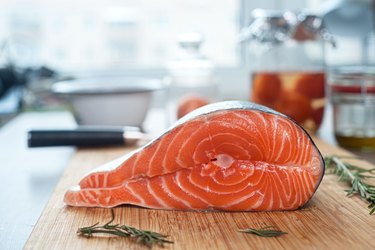
Fish is one of the best sources of protein, omega-3 fatty acids, and other nutrients including iron, potassium and B vitamins. Unfortunately, much of our world's seafood supply is contaminated with high levels of toxic mercury. (You can thank industrial runoff for that!)
Video of the Day
Video of the Day
What Is Mercury?
So, we know that mercury isn't exactly good for you. But before we get into why, let's begin by answering the question, what is mercury?
Methylmercury — the most poisonous among the mercury compounds — is formed when inorganic mercury is dissolved in both freshwater and seawater. The cascade begins when this toxic compound becomes embedded into the food chain after being consumed by phytoplankton, a single-celled alga, which is then consumed by smaller animals.
This is particularly problematic because the smaller fish shed nonorganic mercury as waste, while methyl mercury is retained. As we move up the food chain, smaller fish are consumed by larger fish and those fish are consumed by even bigger fish — all retaining methyl mercury until it makes its way to humans in a process called biomagnification.
Why Is Mercury Bad For Us?
The concern around mercury toxicity is not solely limited to just developing nations — the effects are far-reaching and relevant for all people around the globe. High levels of mercury exposure can also cause damage to the nervous system, with symptoms like tremors, insomnia, memory loss, headaches and cognitive and motor dysfunction, according to the World Health Organization.
And, a July 2012 study in the Journal of Biomedicine and Biotechnology linked high mercury exposure to an increased risk of heart disease. Researchers think this is due to mercury's ability to increase the production of free radicals while reducing antioxidants in the body, which results in oxidative stress. But mercury's effects on the cardiovascular system are not fully understood.
Mercury can also potentially be harmful to developing babies, which is why it's important to eat low-mercury fish during pregnancy.
How Can You Avoid Eating Too Much Mercury?
In general, a good rule of thumb when it comes to mercury content is to consider the size of the fish. Smaller fish such as salmon, scallops, sardines and shrimp contain less mercury than their larger predators such as bigeye tuna and swordfish.
The standard serving size of fish is about four ounces — or the size of the palm of your hand, according to the U.S. Food & Drug Administration (FDA). Use the following guide from the FDA to help you choose fish with the lowest mercury levels and find out how often you should eat other popular types of seafood.
Seafood With the Lowest Mercury Content
Eat no more than 2 to 3 times a week:
- Anchovies
- Atlantic croaker
- Atlantic and Pacific chub mackerels
- Black sea bass
- Butterfish
- Catfish
- Clams
- Cod
- Crab
- Crawfish
- Flounder
- Freshwater trout
- Haddock
- Hake
- Herring
- American spiny lobster
- Mullet
- Oyster
- Perch
- Pickerel
- Plaice
- Pollock
- Salmon
- Sardines
- Scallops
- Shad
- Shrimp
- Skate
- Smelt
- Sole
- Squid (calamari)
- Tilapia
- Tuna (canned light, skipjack)
- Whitefish
- Whiting
Fish With Moderate Levels of Mercury
Eat no more than 1 serving a week:
- Bluefish
- Buffalofish
- Carp
- Chilean sea bass
- Grouper
- Halibut
- Mahi mahi
- Monkfish
- Rockfish
- Sablefish
- Sheepshead
- Snapper
- Spanish mackerel
- Striped bass
- Tilefish
- Tuna (albacore/white tuna, canned or fresh/frozen)
- Yellowfin tuna
- Weakfish/seatrout
- White croaker/Pacific croaker
Fish With the Highest Mercury Levels
Fish to avoid:
- Bigeye tuna
- King mackerel
- Marlin
- Orange roughy
- Shark
- Swordfish
- Tilefish (Gulf of Mexico)
When making choices about seafood, it is important to be an informed consumer who understands the differences between the varieties as well as sourcing of their fish. Seafood, in moderation, can and should be a part of a balanced eating plan thanks to the anti-inflammatory omega-3s and lean protein in fish. In fact, the American Heart Association recommends eating at least two 3.5-ounce servings of fish a week — so choose wisely!
- FDA: "Advice About Eating Fish"
- USDA National Nutrient Database: "Basic Report: 15127, Fish, Tuna, Fresh, Yellowfin, Raw"
- Journal of Preventive Medicine & Public Health: "Methylmercury Exposure and Health Effects"
- Journal of Biomedicine and Biotechnology: "Toxic Effects of Mercury on the Cardiovascular and Central Nervous Systems"
- American Heart Association: "Fish and Omega-3 Fatty Acids"
- WHO: "Mercury and Health"
Was this article helpful?
150 Characters Max
0/150
Thank you for sharing!
Thank you for your feedback!